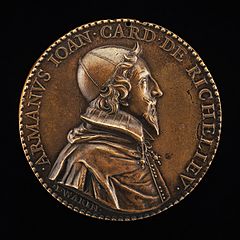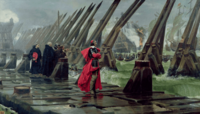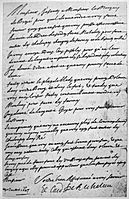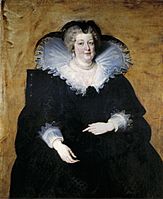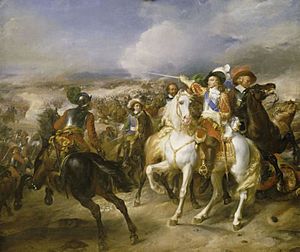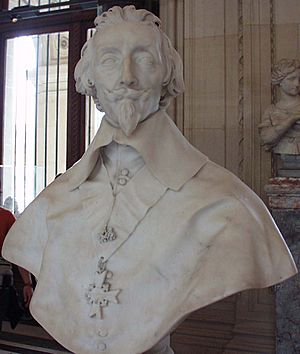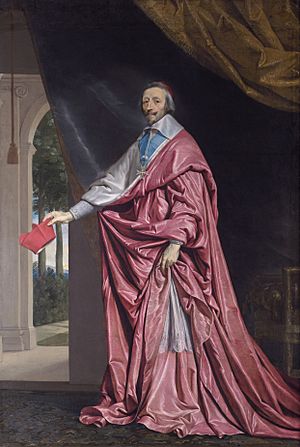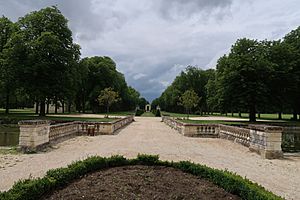Cardinal Richelieu facts for kids
Quick facts for kids
His Grand Eminence
The Cardinal Duke of Richelieu
COHS
|
|||||||||||||||||||||||||||||||||||||
|---|---|---|---|---|---|---|---|---|---|---|---|---|---|---|---|---|---|---|---|---|---|---|---|---|---|---|---|---|---|---|---|---|---|---|---|---|---|
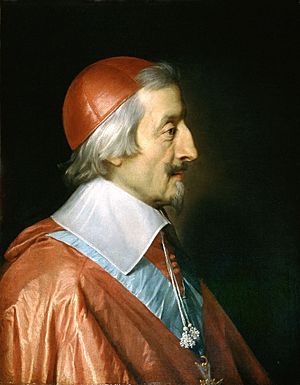
Cardinal de Richelieu by Philippe de Champaigne, 1642 (Musée des Beaux-Arts de Strasbourg)
|
|||||||||||||||||||||||||||||||||||||
| First Minister of State | |||||||||||||||||||||||||||||||||||||
| In office 12 August 1624 – 4 December 1642 |
|||||||||||||||||||||||||||||||||||||
| Monarch | Louis XIII | ||||||||||||||||||||||||||||||||||||
| Preceded by | The Marquis of Ancre Vacant (1617–1624) |
||||||||||||||||||||||||||||||||||||
| Succeeded by | Jules Mazarin | ||||||||||||||||||||||||||||||||||||
| Governor of Brittany | |||||||||||||||||||||||||||||||||||||
| In office 17 April 1632 – 4 December 1642 |
|||||||||||||||||||||||||||||||||||||
| Monarch | Louis XIII | ||||||||||||||||||||||||||||||||||||
| Preceded by | The Marquis of Thémines | ||||||||||||||||||||||||||||||||||||
| Succeeded by | Queen Anne | ||||||||||||||||||||||||||||||||||||
| Grand Master of the Navigation | |||||||||||||||||||||||||||||||||||||
| In office 1626–1642 |
|||||||||||||||||||||||||||||||||||||
| Monarch | Louis XIII | ||||||||||||||||||||||||||||||||||||
| Preceded by | The Duke of Montmorency | ||||||||||||||||||||||||||||||||||||
| Succeeded by | The Marquis of Brézé | ||||||||||||||||||||||||||||||||||||
| Secretary of State for Foreign Affairs | |||||||||||||||||||||||||||||||||||||
| In office 30 November 1616 – 24 April 1617 |
|||||||||||||||||||||||||||||||||||||
| Monarch | Louis XIII | ||||||||||||||||||||||||||||||||||||
| Preceded by | Claude Mangot | ||||||||||||||||||||||||||||||||||||
| Succeeded by | The Marquis of Sillery | ||||||||||||||||||||||||||||||||||||
| Secretary of State for War | |||||||||||||||||||||||||||||||||||||
| In office 25 November 1616 – 24 April 1617 |
|||||||||||||||||||||||||||||||||||||
| Monarch | Louis XIII | ||||||||||||||||||||||||||||||||||||
| Preceded by | Claude Mangot | ||||||||||||||||||||||||||||||||||||
| Succeeded by | Nicolas Brulart de Sillery | ||||||||||||||||||||||||||||||||||||
| Personal details | |||||||||||||||||||||||||||||||||||||
| Born |
Armand Jean du Plessis
9 September 1585 Paris, France |
||||||||||||||||||||||||||||||||||||
| Died | 4 December 1642 (aged 57) Paris, France |
||||||||||||||||||||||||||||||||||||
| Resting place | Sorbonne Chapel | ||||||||||||||||||||||||||||||||||||
| Alma mater | College of Navarre | ||||||||||||||||||||||||||||||||||||
| Profession | Clergyman, statesman | ||||||||||||||||||||||||||||||||||||
|
|||||||||||||||||||||||||||||||||||||
| Styles of Armand Jean du Plessis de Richelieu |
|
|---|---|
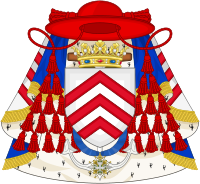 |
|
| Reference style | His Grand Eminence |
| Spoken style | Your Grand Eminence |
| Informal style | Cardinal |
| See | Luçon |
Armand Jean du Plessis, Duke of Richelieu (9 September 1585 – 4 December 1642), known as Cardinal Richelieu, was an important French church leader and politician. People also called him l'Éminence rouge, or "the Red Eminence", because cardinals wear red robes.
Richelieu became a bishop in 1607 and was later appointed Foreign Secretary in 1616. He rose quickly in both the Catholic Church and the French government. He became a cardinal in 1622 and the main minister to King Louis XIII of France in 1624. He held this powerful position until he died in 1642. He was followed by Cardinal Mazarin, whom Richelieu had helped train. Richelieu also had a big disagreement with the king's mother, Marie de Médicis, who used to be his friend.
Richelieu wanted to make the king's power stronger and limit the power of the nobility. His goal was to turn France into a strong, centralized country. In foreign policy, he aimed to weaken the powerful Habsburg family in Spain and Austria. He also wanted France to be the most powerful country in Europe during the Thirty Years' War. Even though he stopped the Huguenot rebellions (uprisings by French Protestants), he made alliances with Protestant countries like England and the Netherlands to achieve his goals.
Richelieu was a student of the University of Paris and head of the College of Sorbonne. He improved and expanded the Sorbonne. He was known for supporting the arts and founded the Académie Française. This group is still in charge of matters related to the French language. He also supported Samuel de Champlain and New France (French colonies in North America). He founded the Compagnie des Cent-Associés to help with colonization. He also helped negotiate the 1632 Treaty of Saint-Germain-en-Laye. This treaty returned Quebec City to French rule after it was lost in 1629.
Richelieu is also famous for inventing the table knife. In 1637, he ordered that all knives at his dining table should have dull, rounded tips. This was because people often used sharp knives to pick their teeth, which he found rude. This new knife design quickly became popular in France and then spread to other countries.
Richelieu often appears in popular stories, especially as the main villain in Alexandre Dumas's 1844 novel The Three Musketeers and its many movies.
Contents
- Early Life and Becoming a Bishop
- Rising to Power in France
- Richelieu as Chief Minister
- France and the Thirty Years' War
- New World Colonies
- Richelieu's Final Years
- Arts and Culture Patronage
- Richelieu's Legacy
- Richelieu in Stories
- Literary Works by Richelieu
- Honors and Namesakes
- Images for kids
- See also
Early Life and Becoming a Bishop
Armand du Plessis was born in Paris on 9 September 1585. He was the fourth of five children. He was often sick throughout his life. His family was part of the lesser nobility from Poitou. His father, François du Plessis, was a soldier and courtier. His mother, Susanne de La Porte, was the daughter of a famous lawyer.
When Richelieu was five, his father died, leaving the family in debt. However, with help from the king, they avoided financial problems. At age nine, young Richelieu went to the College of Navarre in Paris to study philosophy. After that, he started training for a military career.
King Henry III had given Richelieu's family the right to the Bishopric of Luçon. The family used most of the money from this church position for themselves. But other church leaders wanted the money for religious purposes. To protect this income, Richelieu's mother suggested that her second son, Alphonse, become the bishop. However, Alphonse wanted to be a monk instead. So, it became necessary for the younger Richelieu to join the clergy. He was very interested in academics and studied hard for his new role.
In 1606, King Henry IV chose Richelieu to be the Bishop of Luçon. Since Richelieu was not yet old enough, he had to travel to Rome. There, he received special permission from Pope Paul V. Richelieu was made bishop in April 1607. When he returned to his diocese in 1608, he was seen as a reformer. He was the first bishop in France to put into practice the church reforms from the Council of Trent (1545–1563).
Around this time, Richelieu became friends with François Leclerc du Tremblay, also known as "Father Joseph." Father Joseph was a monk who became a close helper to Richelieu. Because he was so close to Richelieu and wore grey robes, Father Joseph was nicknamed L'éminence grise ("the Grey Eminence"). Richelieu often used him for diplomatic talks.
Rising to Power in France
In 1614, church leaders from Poitou chose Richelieu to represent them at the Estates-General. This was a meeting of different groups in France. There, he strongly supported the Church. He argued that the Church should not pay taxes and that bishops should have more political power. He was the most important church leader to support the reforms of the Council of Trent in France. The Third Estate (common people) was against him on this. At the end of the meeting, the First Estate (the clergy) chose him to give the speech about their requests. Soon after, Richelieu started working for King Louis XIII's wife, Anne of Austria, as her almoner (a person who gives out charity).
Richelieu gained political power by serving Queen-Mother Marie de Médicis's favorite, Concino Concini. Concini was the most powerful minister in the kingdom. In 1616, Richelieu became Secretary of State, in charge of foreign affairs. Like Concini, Richelieu was a close advisor to Marie de Médicis. The Queen had become Regent (ruler) of France when Louis was nine. Even though Louis became old enough to rule in 1614, Marie remained the real ruler. However, her policies and Concini's were not popular in France. Many people at court plotted against Marie and Concini. Their main enemy was Charles de Luynes. In April 1617, Luynes arranged a plot. Louis XIII ordered Concini to be arrested, and killed if he resisted. Concini was killed, and Marie de Médicis lost her power. Since his supporter was gone, Richelieu also lost power. He was removed from his job and sent away from the court. In 1618, the King, who still didn't trust Richelieu, sent him to Avignon. There, Richelieu spent most of his time writing.
In 1619, Marie de Médicis escaped from where she was held. She became the leader of a rebellion by nobles. The King and Luynes called Richelieu back. They believed he could talk to the Queen. Richelieu succeeded in this. He helped Marie and her son reach an agreement. This led to the Treaty of Angoulême. Marie de Médicis was given complete freedom, but she had to stay peaceful with the King. The Queen-Mother was also allowed back into the royal council.
After Luynes died in 1621, Richelieu quickly gained power. The next year, the King suggested Richelieu become a cardinal. Pope Gregory XV agreed in September 1622. Problems in France, including a rebellion by the Huguenots, made Richelieu an almost necessary advisor to the King. He was appointed to the royal council of ministers on 29 April 1624. He then worked against the chief minister, Charles de La Vieuville. On 12 August, La Vieuville was arrested for corruption. Cardinal Richelieu took his place as the King's main minister the next day.
Richelieu as Chief Minister
Cardinal Richelieu had two main goals: to make the King's power stronger in France and to oppose the powerful Habsburg family. The Habsburgs ruled both Austria and Spain. Richelieu believed that the Habsburgs' religious goals were bad for France's interests.
Soon after becoming the King's main minister, Richelieu faced a problem in Valtellina, a valley in northern Italy. To stop Spain from taking over the area, Richelieu supported the Protestant Swiss region of Grisons. This region also claimed the important valley. Richelieu sent troops to Valtellina, driving out the Pope's soldiers. This early decision to support a Protestant group against the Pope showed Richelieu's focus on political power rather than just religion in his foreign policy.
To make the King's power even stronger in France, Richelieu wanted to reduce the influence of the feudal nobility. In 1626, he removed the position of Constable of France. He also ordered that all fortified castles be torn down, except those needed for defense. This took away important defenses that nobles could have used against the King's armies during rebellions. Because of this, most nobles hated Richelieu.
Another challenge to the King's power was religious division. The Huguenots, a large Protestant group in France, had a strong military force and were rebelling. Also, the King of England, Charles I, declared war on France to help the Huguenots. In 1627, Richelieu ordered the army to surround the Huguenot stronghold of La Rochelle. The Cardinal himself led the troops. English troops tried to help La Rochelle but failed. The city held out for over a year before surrendering in 1628.
Even though the Huguenots lost badly at La Rochelle, they kept fighting, led by Henri, duc de Rohan. But Protestant forces were defeated in 1629. Rohan agreed to the terms of the Peace of Alais. This meant that Protestants could still practice their religion, as allowed by the Edict of Nantes in 1598. However, Richelieu took away their political rights and protections. Rohan was not executed; he later even became a commander in the French army.
Habsburg Spain used France's conflict with the Huguenots to gain more power in northern Italy. Spain funded the Huguenot rebels to keep the French army busy. Meanwhile, Spain expanded its control in Italy. Richelieu reacted strongly. After La Rochelle surrendered, he personally led the French army to northern Italy to stop Spain. On 26 November 1629, he was made Duke of Richelieu and a Peer of France.
The next year, Richelieu's position was seriously threatened by Marie de Médicis, who had once supported him. Marie believed that Richelieu had taken away her political influence. So, she demanded that her son, the King, fire his chief minister. Louis XIII was at first open to this idea, as he personally disliked Richelieu. But Richelieu was a very convincing speaker and managed to get the King to support him against his own mother. On 11 November 1630, Marie de Médicis and the King's brother, Gaston, duc d'Orléans, got the King to agree to dismiss Richelieu. However, Richelieu knew about the plan and quickly convinced the King to change his mind. This day, known as the Day of the Dupes, was the only time Louis XIII almost fired his minister. After this, the King always supported Richelieu.
Marie de Médicis was then sent away to Compiègne. Both Marie and the duc d'Orléans continued to plot against Richelieu, but their plans failed. The nobility also remained powerless. The only major uprising was by Henri, duc de Montmorency in 1632. Richelieu was harsh in stopping opposition and ordered the duke's execution. In 1634, Richelieu had one of his critics, Urbain Grandier, executed by fire in the Loudun affair. These and other tough actions were used by Richelieu to scare his enemies. He also protected his political power by creating a large network of spies in France and other European countries.
-
Henri Motte's painting of Cardinal Richelieu at the siege of La Rochelle.
-
Letter from Cardinal Richelieu about helping Ré Island during the siege of Saint-Martin-de-Ré, July 1627.
France and the Thirty Years' War

Before Richelieu gained power, much of Europe was involved in the Thirty Years' War (1618–1648). France was not openly fighting the Habsburgs, who ruled Spain and the Holy Roman Empire. So, France secretly gave money and help to the Habsburgs' enemies. Richelieu saw the Dutch Republic as a key ally. It bordered the Spanish Netherlands and was fighting Spain in the Eighty Years' War. Luckily for him, the King had already decided to help the Dutch fight Spain before Richelieu became chief minister. In 1624, France secretly funded a military mission to free the Valtelline from Spanish control. In 1625, Richelieu also sent money to a famous general fighting in Germany. However, in 1626, France needed peace due to high war costs, so they made peace with Spain. This peace quickly broke down due to tensions over the War of the Mantuan Succession.
In 1629, Emperor Ferdinand II defeated many Protestant groups in Germany. Richelieu was worried about Ferdinand's growing power. He encouraged Sweden to join the war and gave them money. Meanwhile, France and Spain remained enemies because of Spain's goals in northern Italy. Northern Italy was a very important area for power in Europe. If the Habsburg armies controlled this region, France would be surrounded by Habsburg lands. Spain also wanted the Pope's approval for a "universal monarchy" (meaning Spain would rule everything). When French diplomats agreed to peace with Spain in 1630, Richelieu refused to support them. That agreement would have stopped France from getting involved in Germany. So, Richelieu advised Louis XIII not to approve the treaty. In 1631, he allied France with Sweden, who had just invaded the empire.
Military costs put a lot of pressure on the King's money. To get more funds, Richelieu raised the gabelle (salt tax) and the taille (land tax). The taille was used to pay for armies and war. The clergy, nobles, and wealthy citizens were often exempt or could easily avoid paying. So, the poorest people had to carry most of the tax burden. To collect taxes better and reduce corruption, Richelieu replaced local tax officials with intendants. These officials worked directly for the King. However, Richelieu's tax plans caused unrest among peasants. There were several uprisings from 1636 to 1639. Richelieu crushed these revolts with force and punished the rebels severely.
Because he openly sided with Protestant powers, many people called Richelieu a traitor to the Catholic Church. At first, military actions were bad for the French, with Spain and the Empire winning many battles. But neither side could win completely, and the war continued after Richelieu's death. Richelieu was key in changing the Thirty Years' War. It went from being a fight between Protestants and Catholics to a fight between different nations and against Habsburg power. France successfully drained the Habsburg empire's resources, pushing it towards bankruptcy. The defeat of Habsburg forces at the Battle of Lens in 1648, along with their failure to stop a French invasion of Catalonia, ended Habsburg control of Europe. In the years that followed, France, led by Louis XIV, would become the most powerful country in Europe.
New World Colonies
When Richelieu came to power, New France (French colonies in North America) had fewer than 100 permanent European settlers. Richelieu encouraged Louis XIII to colonize the Americas. He did this by founding the Compagnie de la Nouvelle France. This company was similar to the Dutch West India Company. Unlike other colonial powers, France encouraged peaceful relations between Native peoples and colonists in New France. They also wanted to include Native Americans in colonial society. Samuel de Champlain, the governor of New France at the time, believed that French and Native people marrying each other would help increase the colony's population.
The 1666 census of New France, taken about 20 years after Richelieu died, showed a population of 3,215 settlers. This was much more than a few decades earlier. However, there was a big difference in the number of men (2,034) and women (1,181).
Richelieu's Final Years

Towards the end of his life, Richelieu upset many people, including Pope Urban VIII. Richelieu was unhappy that the Pope refused to name him the Pope's representative in France. In turn, the Pope did not approve of how the French church was run or France's foreign policy. However, the conflict mostly ended when the Pope made Jules Mazarin, one of Richelieu's main allies, a cardinal in 1641. Despite problems with the Catholic Church, Richelieu did not support completely rejecting the Pope's authority in France.
As he was dying, Richelieu faced a plot to remove him from power. The cardinal had introduced a young man named Henri Coiffier de Ruzé, marquis de Cinq-Mars to Louis XIII's court. Richelieu hoped Cinq-Mars would become the King's favorite. This way, Richelieu could have more influence over the King's decisions. Cinq-Mars became the royal favorite by 1639, but he was not easy to control. The young marquis realized that Richelieu would not let him gain political power. In 1641, he joined a failed plot against Richelieu, but he was not caught. Then, the next year, he planned a rebellion with leading nobles, including the King's brother. He also signed a secret agreement with the King of Spain, who promised to help the rebels. However, Richelieu's spy network discovered the plot. The Cardinal received a copy of the treaty. Cinq-Mars was quickly arrested and executed. Even though Louis approved the execution, he became more distant from Richelieu.
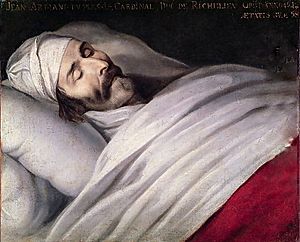
Richelieu was now dying. For many years, he had suffered from fevers, pain, and coughing blood. His doctors kept bleeding him, which made him weaker. As he felt death approaching, he named Mazarin, one of his most loyal followers, to take his place as chief minister to the King.
Richelieu died on 4 December 1642, at age 57. His body was prepared and buried at the church of the Sorbonne.
Arts and Culture Patronage
Richelieu was a famous supporter of the arts. He wrote several religious and political books. He sent people to other countries to find books and old writings for his huge library. In his will, he said his library should be open to scholars at certain times. He also helped many writers with money. He loved theater, which was not respected much back then. He had a private theater, the Grande Salle, in his Paris home, the Palais-Cardinal. One famous writer he supported was Pierre Corneille.
Richelieu also founded and supported the Académie française. This is the most important French literary society. It had existed informally before, but in 1635, Cardinal Richelieu got official permission for it. The Académie française has forty members, promotes French literature, and is the official authority on the French language. Richelieu was its "protector." Since 1672, the French head of state has held this role.

In 1622, Richelieu was chosen as the head of the Sorbonne. He oversaw the renovation of the college buildings and the building of its famous chapel, where he is now buried. Since he was Bishop of Luçon, his statue stands outside the Luçon cathedral.
Richelieu also oversaw the building of his own palace in Paris, the Palais-Cardinal. After Richelieu's death, the palace was renamed the Palais-Royal. Today, it houses important French government offices. The architect of the Palais-Cardinal, Jacques Lemercier, also built a castle and a town for Richelieu in Indre-et-Loire. This project resulted in the Château Richelieu and the town of Richelieu. At the castle, he had one of the largest art collections in Europe. When the Palais-Cardinal was finished, he gave it to the Crown in 1636.
Richelieu's Legacy
Richelieu's time as chief minister was a very important period of change for France. Before him, France's political system was largely feudal. This meant powerful nobles had their own armies and laws in different regions. Some nobles often plotted against the King and allied with foreign powers. Richelieu changed this system to one where power was centralized under the King. Local and even religious interests became less important than the interests of the whole nation and the King.
Richelieu's foreign policy was also very important for France. It helped limit the power of the Habsburg family in Europe. Richelieu died before the Thirty Years' War ended. However, when the war finished in 1648, France was in a much stronger position than any other country. The Holy Roman Empire began to decline.
Richelieu's successes were very important for King Louis XIV, who followed Louis XIII. Louis XIV continued Richelieu's work of creating an absolute monarchy. Like the Cardinal, he made policies that further weakened the nobles and completely destroyed the political power of the Huguenots. Louis XIV also used France's success in the Thirty Years' War to make France the most powerful country in Europe during the late 1600s.
Richelieu is also known for the strict ways he kept power. He censored the press, created a large network of spies, and stopped public discussions of political matters. He had those who plotted against him arrested and executed. Some historians call Richelieu the "father of the modern nation-state" and the "modern secret service."
Historians often debate Richelieu's true reasons. Some see him as a patriotic supporter of the monarchy. Others view him as someone who only cared about gaining power. The second idea became more popular because of Alexandre Dumas' The Three Musketeers. In this book, Richelieu is shown as a selfish and cruel ruler of France.
Despite these debates, Richelieu is still an honored figure in France. Several places and things are named after him, including a battleship and a battleship class.
His legacy is also important for the whole world. His ideas of a strong nation-state and aggressive foreign policy helped create the modern system of international politics. Ideas like national sovereignty (a country's right to govern itself) and international law can be traced back to Richelieu's policies and ideas. This is especially true for the Peace of Westphalia treaty that ended the Thirty Years' War.
His new way of handling French diplomacy, using "reason of state" (doing what's best for the country) in power struggles, was first criticized. But later, other European countries copied it to improve their own diplomatic strategies.
Another less known part of his legacy is his involvement with Samuel de Champlain and the new colony along the St. Lawrence River. Richelieu's support for Canada helped it grow into a French empire in North America. Parts of this empire later became modern Canada and Louisiana.
Richelieu in Stories
As of April 2013, the Internet Movie Database listed 94 films and TV shows where Cardinal Richelieu is a character. He is one of the church leaders most often shown in movies, especially in the many versions of Alexandre Dumas's The Three Musketeers. He is usually shown as a bad character. However, the 1950 film Cyrano de Bergerac shows Richelieu as kind to Cyrano's money problems. He also seems to enjoy the duel at the theater.
Actors who have played Cardinal Richelieu in movies and on TV include Nigel De Brulier, George Arliss, Miles Mander, Vincent Price, Charlton Heston, Aleksandr Trofimov, Tcheky Karyo, Stephen Rea, Tim Curry, Christoph Waltz and Peter Capaldi.
Richelieu is mentioned in a famous line from Alessandro Manzoni's novel The Betrothed (1827–1840). The story is set in 1628. A peasant from Lombardy shares his ideas about bread riots happening in Milan.
The 1839 play Richelieu; Or the Conspiracy, by Edward Bulwer-Lytton, has Richelieu say the famous line, "The pen is mightier than the sword." This play was made into the 1935 film Cardinal Richelieu.
The Monty Python's Flying Circus episode "How to Recognise Different Types of Trees from Quite a Long Way Away" (1969) features a sketch called "Court Scene with Cardinal Richelieu." In it, Richelieu (played by Michael Palin) does very silly things.
In the 1632/Ring of Fire book series by Eric Flint, Richelieu is one of the main bad guys against the new United States of Europe.
Richelieu and Louis XIII are shown in Ken Russell's 1971 film The Devils.
Literary Works by Richelieu
- Political Testament
- The principal points of the faith of the Catholic Church defended (1635)
Honors and Namesakes
Many places and landmarks are named to honor Cardinal Richelieu. These include:
- Richelieu, Indre et Loire, a town founded by the Cardinal
- Avenue Richelieu, in Shawinigan, Quebec, Canada
- The provincial voting district of Richelieu, Quebec
- Richelieu River, in Montérégie, Quebec
- Richelieu Squadron, a group of Officer Cadets from the Royal Military College Saint-Jean
- A wing of the Louvre Museum, Paris, France
- Rue de Richelieu, a street in Paris named in his honor. Places on this street include the Paris Métro station Richelieu-Drouot and the historical site of the Bibliothèque nationale de France.
There is also a fancy style of lace, Richelieu lace, named after the cardinal.
Images for kids
See also
 In Spanish: Cardenal Richelieu para niños
In Spanish: Cardenal Richelieu para niños



